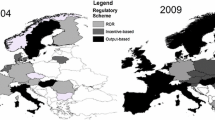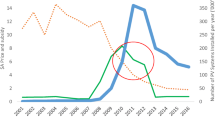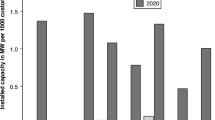Abstract
The development of decentralized sources of power out of renewable sources of energies has been triggering far-reaching consequences for Distribution System Operators over the past decade in Europe. Our paper benchmarks across 23 European countries the impact of the development of renewables on the physical characteristics of power distribution networks and on their investments. It builds on a large spectrum of databases of quantitative indicators about the dynamics of installed capacity of renewable energy resources and the power generation out of them, electricity independence, quality of electricity distribution, smart grids investments, Network System Operators capital expenditures, length of the distribution networks, overall costs of power networks paid by private agents, and electricity losses, all in relation with the development of decentralized generation. The heterogeneity of these indicators across Europe appears to be wide notably because of physical constraints, historic legacies, or policy and regulatory choices. A cluster analysis allows for deriving six groups of countries that display statistically homogenous characteristics. Our results may provide decision makers and regulators with a tool helping them to concentrate on the main issues specific to their countries as compared to the European median, and to look for possible solutions in the experience of other clusters which are shown to perform better for some indicators.











Similar content being viewed by others
Notes
In the Eurostat database, biomass data are not available. We thus rely on Eurostat’s definition to compute biomass capacity. Biomass is defined as biogas, wood and wood waste, and organic urban waste (data were found on Eurostat as well).
French and Irish data are available on a shorter period, from 2011 and 2012, respectively. Household network costs in the UK are not available in 2010. According to Energy UK, network costs amounted for 23% of the electricity bill in 2010. We applied this percentage to the electricity price provided by Eurostat to get a proxy of the variable in 2010 in the UK.
Cf. CEER Benchmarking Report 5.1 on the continuity of electricity supply, February 2014. SAIDI assesses the average interruption time on low-voltage network. This index is used internationally for assessing electric grid reliability.
For Norway, only “unplanned events” data were available.
Countries with a high population density and a high number of clients, such as Belgium and the Netherlands, have a lower network length than countries with a lower population density and a lower number of clients such as Finland or Sweden.
Notice that the sample period varies from one pair of variables to another due to a lack of data. We did not consider the shortest common period to all indicators (2009–2014). This would have led to a loss of interesting information, since many countries have launched their energy transition earlier.
The relatively low progression of renewables could be also the consequence of a high share of hydro power in the renewable mix of these countries. Indeed, hydro power amounts for more than 60% of their renewable mix (see Figure 1). Hydropower can deliver more rapidly back-up generation when the intermittency of renewables is too high, compared to conventional power [61].
This low progression could also be explained by the rise of investments in small scale DG, which add less capacities compared to large scale wind in Denmark for example, such as biomass in the residential sector [84]. Consequently, the low progression of renewables in Sweden does not mean that Sweden does not invest anymore.
The favorable connection rules and schemes for renewables, e.g., a shallow charging approach and priority of connection and access, have also incentivized the investments in new capacities in Germany. With the shallow charging approach, the RES installation operator has to pay for only the connection costs to the network, but not the reinforcement and extension costs needed to expand the lines from the nearest connection point to the installation, which are passed through to consumers (Swiders et al. 2008).
Note that only the electricity independence indicator is compared to RES electricity generation as the electricity independence is computed from electricity generation.
There is no link between electricity independence and SAIDI. Electricity independence reflects the ability of a country to match fully its local demand by its local electricity generation. By contrast, SAIDI is an indicator that reflects the average system interruption onto the network experienced by customers. The interruption usually emanates from technical issues such as overload and voltage fluctuations.
Grid-level system costs comprise back-up costs, balancing costs, grid connection costs, and grid reinforcement and extension costs.
See Jain [54] for a review of this method and some extensions.
The Euclidian distance is the square root of the sum of the squared differences in the values of the variables. For instance, the distance between the two countries A and B with regard to three variables x, y, and z is given by \( \left\Vert A-B\right\Vert =\sqrt{{\left({x}_A-{x}_B\right)}^2+{\left({y}_A-{y}_B\right)}^2+{\left({z}_A-{z}_B\right)}^2} \).
This was also the case of the variable X3 “net electricity generation from renewable sources.” However, this indicator in level was highly correlated to the renewable installed capacity in level.
The results obtained on the three subsets of variables are available from the authors upon request.
References
ABS Energy Research (2006). British utility market report. Ed. 3 2006.
Ackermann T. (2013), "What Matters for Successful Integration of Distributed Generation", presented at IEA Workshop, Paris, October 1st 2013. http://www.iea.org/media/workshops/2013/futurechallenges/9ackermann.pdf.
Agora EnergieWende (2013). Cost optimal expansion of renewables in Germany: a comparison of strategies for expanding wind and solar power in Germany.
Anaya K. and Pollitt M. (2014). Integrating distributed generation: regulation and trends in three leading countries, Working Paper 1423, University of Cambridge.
Auer H. et Haas R. (2016), On integrating large shares of variable renewables into the electricity system, energy, Vol. 115, pp. 1592–1601.
Bayer E. (2015). Report on the German power system, Agora EnergieWende.
Bialek J. and Pollitt M. (2007). Electricity network investment and regulation for a low carbon future, Cambridge University working papers in economics, EPRG 0721.
Bichler M. (2012). Smart grids and the energy transformation: Mapping smart grid activities in Germany, smart energy for Europe platform (SEFEP) working paper.
Blokhuis, E., Brouwers, B., van der Putten, E., & Schaefer, W. (2011). Peak loads and network investments in sustainable energy transitions. Energy Policy, 39(10), 6220–6233.
Bundesnetzagentur (2013). Monitoring report 2012.
Bundesnetzagentur (2014). Monitoring report 2013.
Cali U., Ropenus S. and Schroder S. (2009). Development of interactions between distributed generation and distribution system operators: West Denmark, Germany, The Netherlands, Spain and The United Kingdom.
Cambini, C., Meletiou, A., Bompard, E., & Masera, M. (2016). Market and regulatory factors influencing smart-grid investment in Europe: evidence from pilot projects and implications for reform. Utilities Policy, 6, 36–47.
ClimateAction (2016). Municipalities in Italy using renewables to provide 100% of their energy, http://www.climateactionprogramme.org/news/municipalities_in_italy_using_renewables_to_provide_100_of_their_energy.
Coelli, T., Gautier, A., Perelman, S., & Saplacan-Pop, R. (2013). Estimating the cost of improving quality in electricity distribution: A parametric distance function approach. Energy Policy, 53, 287–297.
Commission for Energy Regulaiton (2010), "Decision on 2011 to 2015 distribution revenue for ESB Networks Ltd.
Cossent, R., Gomez, T., & Frias, P. (2009). Towards a future with large penetration of distributed generation: Is the current regulation of electricity distribution ready? Regulatory recommendations under a European perspective. Energy Policy, 37(3), 1145–1155.
Cossent, R., Gomez, T., & Olmos, L. (2011). Large scale integration of renewable and distributed generation of electricity in Spain: Current situation and future needs. Energy Policy, 39(12), 8078–8087.
Council of European Energy Regulators (2014). CEER Benchmarking Report 5.1 on the continuity of electricity supply - Data update.
Council of European Energy Regulators (2016). 6th CEER Benchmarking Report on the quality of electricity and gas supply.
Covrig C., Ardelean M., Vasiljevska J., Mengolini A., Fulli G. and Amoiralis E. (2014). Smart grids projects outlook 2014, Joint Research Center of The European Commission.
Danish Energy Regulatory Authority (2015). 2015 National Report to the European Commission—Denmark.
Danish Ministry of Climate, Energy and Building (2012). Energy Policy Report 2012.
de Joode, J., Jansen, J. C., van der Welle, A. J., & Scheepers, M. J. J. (2009). Increasing penetration of renewable and distributed electricity generation and the need for different network regulation. Energy Policy, 37(8), 2907–2915.
de Joode J., van der Welle A. and Jansen J. (2010), Distributed generation and the regulation of distribution networks.
Deloitte (2016a). European energy market reform—country profile: Spain.
Deloitte (2016b). European energy market reform—Country profile: Belgium.
Dondi, P., Bayoumi, D., Haederli, C., Julian, D., & Suter, M. (2002). Network integration of distributed power generation. Journal of Power Sources, 106, 1–9.
E-Bridge, OFFIS and Institute für Elektrische Anlagen und Energiewirtschaft (2014). Moderne Verteilernetze für Deutschland, Study for the Federal Ministry of Economics and Technology, Management Summary.
Eclareon (2011), Integration of electricity from renewables to the electricity grid and to the electricity market-RES-Integration: Austria, https://www.eclareon.com/sites/default/files/austria_-_res_integration_national_study_nreap.pdf.
Enerdata (2013). Smart grids and network regulation: the regulatory framework is still not in place, Webinar of the Clean Energy Solutions Center.
Energie-Control Austria (2014). Market report 2014—National report to the European Commission.
Energy Regulators Regional Association (ERRA) (2013). Regulatory practices supporting deployment of renewable generators through enhanced network connection, ERRA Issue Paper.
Eurelectric (2014). Power distribution in Europe.
EurObserv'ER (2013) "The state of renewable energies in Europe", 13th EurObserv'ER Report
European Commission (2010). State aid: Commission approves aid for new 400 MW thermal power plant in Latvia, http://europa.eu/rapid/press-release_IP-10-86_en.htm?locale=en .
European Commission (2013). Member States’ energy dependence: an indicator-based assessment, European Economy Occasional Paper.
European Commission (2014). Country reports: progress towards completing the internal energy market, Commission staff working document.
European Commission (2016). Clean energy for All Europeans—unlocking Europe’s growth potential. Press release IP/16/4009, Brussels, November 2016. http://europa.eu/rapid/press-release_IP-16-4009_en.htm.
European Parliament (2010). "Decentralized energy systems".
EY (2015). Mapping power and utilities regulation in Europe.
Gangale F., Vasiljevska J., Covrig C.F., Mengolini A. et Fulli G. (2017). Smart grid projects outlook 2017, JRC Science for Policy Report of the European Commission.
Global Legal Insights (2017). Belgium - Energy 2017, https://www.globallegalinsights.com/practice-areas/energy/global-legal-insights --- energy-5th-ed./belgium.
Hansson M. and Carlsson F. (2014). The potential of renewable energy in the Swedish distribution networks: a case study in southern Sweden.
Happel T. (2009). Belgium’s energy market, U.S. Commercial Service.
Hungarian National Regulatory Authority (2014). Report on the activities of the Hungarian Energy and Public Utility Regulatory Authority in 2013.
International Energy Agency (2011a). Methodology used to calculate T&D investments.
International Energy Agency (2011b), Technology Roadmap: smart grids.
International Energy Agency (2011c). World Energy Outlook.
International Energy Agency (2015). Feed-in tariffs (FITs)forelectricity from renewables-Bulgaria, https://www.iea.org/policiesandmeasures/pams/bulgaria/name-25061-en.php.
International Energy Agency (2016). World energy investment 2016.
International Trade Administration (2016). Bulgaria—power generation, https://www.export.gov/article?id=Bulgaria-Power-Generation-Oil - and-Gas-Renewable-Sources-of-Energy-and-Energy-Efficiency.
Jaehnert, S., Wolfgang, O., Farahmand, H., Völler, S., & Huertas-Hernando, D. (2013). Transmission expansion planning in northern Europe in 2030—methodology and analyses. Energy Policy, 61, 125–139.
Jain, A. K. (2010). Data clustering: 50 years beyond K-means. Pattern Recognition Letters, 31, 651–666.
Jarventausta P, Verho P., Partanen J. and Kronman D. (2011). Finnish smart grids—a migration from version one to the next generation, 21st International Conference on Electricity Distribution, Paper 1000.
Kema LDA (2011). Study on the impact of distributed generation on the national electricity system, Paper submitted to Entidade Reguladora dos Serviços Energéticos (ERSE).
Ketterer, J. C. (2014). The impact of wind power generation on the electricity price in Germany. Energy Economics, 44, 270–280.
Kunz, F. (2013). Improving congestion management: how to facilitate the integration of renewable generation in Germany. Energy Journal, 34(4), 55–78.
Lehtonen, M., & Nye, S. (2009). History of electricity network control and distributed generation in the UK and Western Denmark. Energy Policy, 37(6), 2338–2345.
Martin J. (2009). Distributed vs. centralized electricity generation: Are we witnessing a change of paradigm?
McDonald M. (2003). Renewable network impact study. Annex 4: Intermittency literature survey, The Carbon trust and the Department of Trade and Industry, https://www.uvig.org/resources/carbon-trust-dti-renewables-network-impact-study-annex-4-intermittency-literature-survey - roadmap-november-2003/.
McDonald, J. (2008). Adaptive intelligent power systems: active distribution networks. Energy Policy, 36(12), 4346–4351.
Mendez Quezada, V., Rivier Abbad, J., & Gomez San Roman, T. (2006). Assessment of energy distribution losses for increasing penetration of distributed generation. Institute of Electrical and Electronics Engineers Transactions on Power Systems, 21(2), 533–540.
Ministry of the Environment of the Republic of Latvia (2006) Report of the Republic of Latvia on Demonstrable Progress under the Kyoto Protocol to the United Nations Framework Convention on Climate Change.
Miri-Larimi S.M., Haghifam M.-R. and Jalilzadeh E. (2012). Optimal sitting and sizing of renewable energy resources in distribution network with bi-level optimization, CIRED Workshop.
Morales Pedraza J. (2015). Electrical energy generation in Europe: The current and future role of conventional energy sources in the regional generation of electricity. Springer.
Morris C. and Pehnt M. (2014). Energy transition: the German EnergieWende, Heinrich Boll Stiftung.
Nijhuis, M., Gibescu, M., & Cobben, J. F. G. (2015). Assessment of the impacts of the renewable energy and ICT driven energy transition on distribution networks. Renewable and Sustainable Energy Reviews, 52, 100–1014.
Nijhuis, M., Gibescu, M., & Cobben, J. F. G. (2017). Analysis of reflectivity & predictability of electricity network tariff structures for household consumers. Energy Policy, 109, 631–641.
Northeast Group (2016). Germany smart grid: market forecasts (2016–2026).
Observatoire des Energies Renouvelables (Observ’ER) en collaboration avec EDF et la Fondation Energie pour le monde (2013). La production d’électricité d’origine renouvelable : détails par région et par pays quinzième inventaire.
Ofgem (2014), Community energy grid connections—working group report to the Secretary of State, https://www.ofgem.gov.uk/sites/default/files/docs/2014/11/grid_connections_011214.pdf.
Ofgem (2015). Regional differences in network charges.
Ofgem (2016). Renewables obligation - Annual Report 2015–2016.
Ölz S., Sims R. and Kirchner N. (2007). Contribution of renewables to energy security, International Energy Agency.
Paraschiv, F., Erni, D., & Pietsch, R. (2014). The impact of renewable energies on EEX day-ahead electricity prices. Energy Policy, 73, 196–210.
Parr M. (2015). Networks costs and renewables: a Euro view, Transmission & Distribution Magazine, http://tdworld.com/generation - renewables/network-costs-renewables-euro-view.
Poblocka A., Tallat-Kelpsaite J., Spitzley JB, Covarrubias Sieber M., Bauknecht D. (2011), Integration of electricity from renewable to the electricity grid and to the electricity market - RES-integration: National report Lithuania.
Regional Center for Energy Policy Research & Danube Region Strategy Energy (2014). Smart grids in the Danube Region countries.
REKK (2013). Regulatory practices supporting deployment of renewable generators through enhanced network connection, ERRA and NARUC joint paper.
RES Legal (2017). Legal sources on renewable energy, http://www.res-legal.eu/search-by-country/.
Rintamäki, T., Siddiqui, A. S., & Salo, A. (2017). Does renewable energy generation decrease the volatility of electricity prices? An analysis of Denmark and Germany. Energy Economics, 62, 270–282.
Robinson D. (2013). Pulling the plug on renewable power in Spain, The Oxford institute for energy studies - University of Oxford, Oxford energy comment.
Ruggiero, S., Varho, V., & Rikkonen, P. (2015). Transition to distributed energy generation in Finland: prospects and barriers. Energy Policy, 86, 433–443.
Samad T. and Annaswamy A. (2011). The impact of control technology, Institute of Electrical and Electronics Engineers.
Shaw, R., Attree, M., & Jackson, T. (2010). Developing electricity distribution networks and their regulation to support sustainable energy. Energy Policy, 38(10), 5927–5937.
Simkus A. (2012). Reshaping energy sector in the Baltics: towards energy independence, Lawin.
Slingerland S., Rothengatter N., Van Der Veen R., Bolscher H. and Rademaekers K. (2015). The balance of power—flexibility options for the Dutch electricity market, Triple Group.
St. John J. (2012). Report: German utilities don’t want to spend on smart grid, http://www.greentechmedia.com/articles/read/report-german - utilities-dont-want-to-spend-on-smart-grid.
Swider, D. J., Beurskens, L., Davidson, S., Twidell, J., Pyrko, J., Pruggler, W., Auer, H., Vertin, K., & Skema, R. (2008). Conditions and costs for renewables electricity grid connection: examples in Europe. Renewable Energy, 33, 1832–1842.
Targosz R. (2008). Reducing electricity network losses. http://www.leonardo-energy.org/reducing-electricity-network-losses .
Van Nuffel L., Rademaekers K., Yearwood J. and Graichen V. (2017). European energy industry investments, directorate general for internal policies of the European Parliament, Policy Department A: Economic and Scientific Policy.
Vilchez E., Stenzel J. (2013). Impact of renewable energy generation technologies on the power quality of the electrical power systems, CIRED 22nd International Conference on Electricity Distribution.
VTT (2009). Design and operation of power systems with large amounts of wind power, http://www.vtt.fi/inf/pdf/tiedotteet/2009/T2493.pdf .
Wang L. (2008). Integration of renewable energy sources: reliability-constrained power system planning and operations.
Author information
Authors and Affiliations
Corresponding author
Appendix
Appendix
Rights and permissions
About this article
Cite this article
Corbier, D., Gonand, F. & Bessec, M. Impacts of Decentralized Power Generation on Distribution Networks: a Statistical Typology of European Countries. Environ Model Assess 23, 471–495 (2018). https://doi.org/10.1007/s10666-018-9621-7
Received:
Accepted:
Published:
Issue Date:
DOI: https://doi.org/10.1007/s10666-018-9621-7




